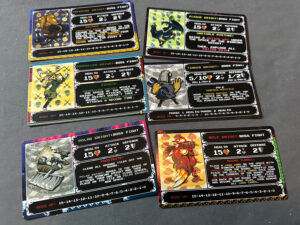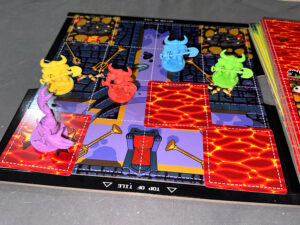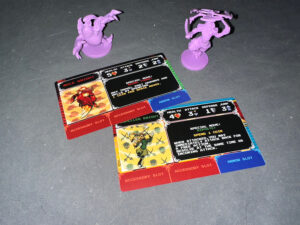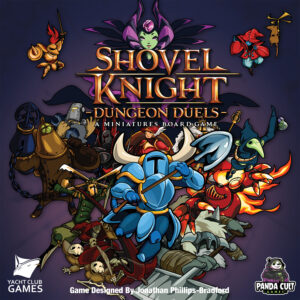 Popular video games seem like a natural place to look when looking for new board game themes. After all, they are already a game, and the themes have proven popular in their original medium. The road to adapting a video game to a board game, however, has proven to be a rocky one, as such adaptations have a spotty track record. For every Boss Monster that knocks it out of the park, you can find a game that struggled to make the transition, like Shadowgate: The Living Castle. With a big box footprint and an equivalent price point, Shovel Knight hopes to be the former, but is it more like the latter?
Popular video games seem like a natural place to look when looking for new board game themes. After all, they are already a game, and the themes have proven popular in their original medium. The road to adapting a video game to a board game, however, has proven to be a rocky one, as such adaptations have a spotty track record. For every Boss Monster that knocks it out of the park, you can find a game that struggled to make the transition, like Shadowgate: The Living Castle. With a big box footprint and an equivalent price point, Shovel Knight hopes to be the former, but is it more like the latter?
Shovel Knight: Dungeon Duels is a game for 1-4 players, and it plays in 90 minutes.
Gameplay Overview:
In a game of Shovel Knight, you are competing to prove your worth as the one true Shovel Knight by collecting treasure and defeating enemies on your way to defeating a dungeon’s final boss. The game is technically a competitive game, but you cannot attack your fellow Shovel Knights. Defeating the boss at the end of the dungeon also takes a group effort, so there are some elements that feel cooperative. However, while you can’t directly harm other players, you can be quite…rude and push them into enemies, traps, and other unfortunate situations. If something bad happens to them, it isn’t your fault, after all.

The most unique aspect of the game is the board. There are two primary stages of the game: the dungeon (and the plains surrounding it) and the final boss. During the first stage, the tiles function like a side-scrolling video game. At the end of each round, one of the four tiles slides off to the left and is discarded (woe to any players or enemies still on that tile), the remaining three are moved to the left, and a new one is placed on the right side. Everything on the tiles, moves with them. The goal of this first stage is mostly to survive, but you do also need to be defeating enemies and unearthing treasure. Defeating enemies earns you Coins, and treasure mounds can get Coins or Loot. Both are useful on your path to victory, but getting greedy can be counterproductive, as taking too much time and side-scrolling off the edge of the board, means you are instantly defeated!
After fighting, jumping, looting, and shoveling your way through the dungeon, when the dungeon tiles run out and all the players exit off the final edge, the dungeon tiles are cleared and the fight with the dungeon’s boss begins. There are nine different bosses (mostly, different types of Knights, like King Knight, Mole Knight, Tinker Knight, etc.), and all of them have an AI deck that determines their attacks, as well as their own unique end-of-round attack. The fight is usually challenging, and if the players succeed in defeating the boss, the player with the most Coins is the ultimate winner.

Game Experience:
There is a lot to do as a player. On your turn, you have a wide variety of options available to you. The list of potential actions is long: move, jump, stand, collect treasure, buy gear, and more. Most of the options are fairly simple, and function like you would expect. Primarily the jump and attack actions are a bit more complicated, as they are resolved with the game’s custom dice. The dice have various amounts of jump, attack, and defense icons. When you’re making a roll, you only look at the specific icon for the action you’re performing. If attacking, you want shovels; if jumping, you want arrows; and if you’re being attacked, you want shields. Jumping is largely unopposed, and you can just jump the number of spaces equal to icons you roll, while attacking compares your shovel results to the defender’s shield results to determine if they get any wounds. Otherwise, the actions act like you’d expect from their descriptions.

The side-scrolling aspect is one of the stars of the show here. It is what makes the game feel thematically accurate, and it is really quite unique. I’m not sure I have played a game previously that replicates it. It puts a timer on the stage so the game cannot really go too long, while also creating a sense of urgency to everything you are doing. Do you risk going for that extra treasure pile and maybe end up getting pushed into a spike trap or off the board? It does make for some interesting decisions throughout the course of the game.
The other thing that works really well in the first stage of the game is the variety. There are nine bosses and they each have their own sets of dungeon tiles. You always start with the Plains of Passage for four tiles, but the rest of the dungeon tile stack is composed of tiles unique to the boss you are fighting. There are new obstacles and challenges to face on your way to the boss depending on which dungeon you are in. The Explodatorium, Iron Whale, and Sunken Ship, for example, all feature different obstacles and rules. There are certain basic commonalities between all the dungeons, such as Spike Traps and Chester the purveyor of equipment (you really should ask him how he gets into every dungeon safely…). This variety carries forward to the boss stage as well. Fighting each boss, while you are mechanically doing the same thing (drawing an AI card between each player’s turn or doing the boss’s special attack at the end of the round), they are all designed to be quite different. It ensures that the game never gets stale. There’s always something new and different.

Most of this has been good, but I do have some concerns. The rules are very thick. The rulebook is 60 pages long. That seems like a lot more than it needs to be, and it really bogs the game down a bit. It takes some time to figure things out, particularly as questions come up during the game, as it isn’t necessarily easy to find the answers, and some of the rules are complicated enough that there might not actually be an answer. Once you learn the game, this doesn’t feel like as much of an issue, but the sizable rulebook and the answers not being always straightforward (and where you expect them to be… the victory conditions aren’t stated until the middle of the boss rules, for example), feels like it is really a barrier to someone wanting to learn the game.
The other big issue would be the length of a game. While it isn’t super-long, the break between the dungeon stage and the boss stage makes it feel like it is long, as you must pause the action, tear down the remainder of the dungeon stage, and set up the boss fight stage. Combined with the normal set up at the start of the game having a good number of components, the game time is increased a bit more than you’d expect simply due to set-up. A nice workaround to that can be playing just the boss stages.
To not end on a down note, the game does provide an impressive table presence. The miniatures look nice, and the tile components for the dungeons are beautiful and seem to hold up pretty well. Aesthetically it fits the look of the game it is based on and is very whimsical. I think I read there is a standee version out there, but it is comparatively rare, and most copies are the miniatures version. I have not seen the standees, but I would guess they are not as impressive as the miniature version.

Final Thoughts:
This is an enjoyable game, but it does have some flaws, with the rules probably being the biggest offender. Since it is a bit of a commitment to set up, and often a rules question comes up that can take a bit to get a satisfying answer for, it can be difficult to get the game to the table reliably. Which is a shame because it looks great, and most of the time it is pretty fun. In terms of video game dungeon crawls turned into board games (which is itself a pretty niche description), I would definitely want to play this over Shadowgate, but the setup and occasional rules struggle can make that harder to pull off with a group.
While the rules are certainly a barrier to entry, I think one of the game’s greatest strengths is also its greatest weaknesses. The miniatures are great, but they put the price point pretty high. This is a big box, with a big price. It looks nice, but is the gameplay really worth over $100? The replayability is certainly there. You get a lot of unique games for that $100, assuming you can get people to play it enough times to see that variety.
Overall, I think if you’re willing and able to get through the slow-going that the rules cause while you’re learning the game, the minis and the unique gameplay when combined with the great amount of variety that the basic set up allows for makes the game worth picking up and trying. I know I labored on the issues a little bit, and I don’t want that to overshadow that the game is largely pretty good. I would have liked a little better, but at the end of the day it is a game I am willing to play again.
Final Score: 3.5 Stars – A fun game that hits its intended theme really well with some unique mechanics that is let down by an overlong time and a rulebook in need of improvement.
 Hits:
Hits:
• The side-scrolling mechanic is unique and interesting.
• Different dungeon tiles and rules for each final boss allow for very different games from start to finish.
• Production on the minis is very well done, and the tiles are thematically on point.
Misses:
• Set-up of the second stage drags the game time longer than it needs to be.
• The rulebook is long, not well-organized, and sometimes doesn’t have satisfactory answers to questions… it could have been better.
Source: Board Game Quest





